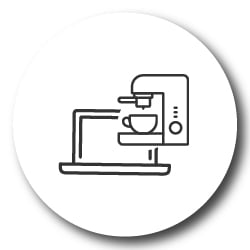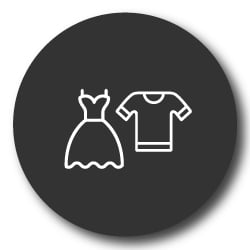While retail inventory is broad - there are multiple types of products across various categories - you can also filter it into two distinct groups. On the one hand, are your hardlines. On the other, are your softlines. Often squared off against each as Hardlines vs Softlines, it’s crucial to approach each differently. Why? Because each has a different effect on your business.
What’s more, it’s crucial to understand these differences so you can maximize the selling potential of your space. Also, so that you can provide a shopping experience that your shoppers will want to have again and again.

Hardlines vs Softlines: What are they exactly?
Before we take a look at how to get the most out of your hardlines and softlines, it’s first worth unpacking them in more detail. As already alluded to above, hardlines and software are both categories of retail inventory.
Here’s a little more detail. First up hardlines.
Also known as hard goods, hardlines are non-personal items and can cover a broad range of categories such as consumer electronics and home appliances. Add to that the fact that the gross margin of your hardline goods is usually lower than that of softlines.
Why? Considering the general cost of electronics and appliances, the average consumer won’t buy these types of goods regularly. They see them as an investment, bought once every few years. Knowing this, it’s always worth carrying accessories with higher margins to offset the lower margins on your televisions, washing machines, and other such goods should you stock them.
As for softlines, that’s simple. If hardlines are your non-personal goods, softlines are the opposite - they’re personal. Also known as soft goods, they refer to clothing, linen, footwear, and other soft products.
What’s interesting though, is that while there is a clear divide between the two categories of merchandise, that doesn’t always translate to retailers. By that, we mean you’re not limited to stocking one or the other.
Of course, the size of your retail business and how much capital you have does play a part in the final decision. Because of the costs of carrying inventory, it might be a better idea to specialize in one type if you’re a small retailer.
Another factor to consider is your initial setup and the image you want to portray. What type of goods do you want to stock? And, what do you want your customers to think of when they think of your brand?
Let’s say, for example; you’re an independent retailer specializing in soft goods. You’d want customers to know you for your clothing or linen, so it’s worth investing your time and money into building a brand around that.
It’s not a good idea to suddenly begin stocking hard goods because that’ll only confuse shoppers and could even dilute your retail brand.

What to consider when stocking hardlines in-store
When it comes to stocking hard goods in your store or choosing to begin stocking such items, there are a few things that you need to know.
Easier to organize and merchandise
The first thing to know is that hardlines are easier to organize in your store. That’s because of their size and general packaging. Since many such goods are in boxes, it makes it easier for you to present them in-store.
What’s more, that makes it easier to merchandise on your shelf as you have set dimensions with which to work. If you reduce the size of your packaging, there is every chance of using less shelf space per product, which means you can include more products in your store. That’s especially helpful if you can stock more of your favorite products than your unpopular ones.
Of course, not all hard goods are packaged neatly. For example, sporting goods are not of all shapes and sizes as are some kitchenware.
Shoppers do not affect your displays
A second point to consider is that any displays created by you are difficult for your customers to mess up. That means once you’ve created a display, you have more control over how it looks throughout the day.
For example, if someone wants to buy a refrigerator that’s in the center of your display, instead of taking it out and refilling the gap, you can find the stock in your storeroom, thereby keeping the display as is.
It’s the same for just about any other display in your store.
Creating a floor plan is essential
Lastly, you must create a floor plan.
While a well-designed floor plan - using your retail data - is critical to your store regardless of the products you stock, it’s even more so if you stock hard goods.
Why?
It’s to guide your customers through your store and encourage them to see all of your products in your store.
Since you can view hardline goods as costly investments - a customer walks into your store knowing they’ll buy a television, for example. They’re likely to walk straight to that section in your store without browsing or looking at other products. However, you can create a path for your customers to walk, and as they do, present them with other products.
As they walk past them, they might realize they need additional products. And, before they know it, instead of buying only a television, they’ve purchased a few accessories and other goods.

What to consider when stocking softlines in-store
While there are many considerations to make when stocking hardlines, the same goes for if you want to carry soft goods.
They are more challenging to organize
While it’s easier to organize and merchandise hard goods because of their size and general uniformity, it’s not necessarily the same for soft goods. That’s because of the number of products you’re likely to stock at any given time.
That’s not to say that it’s impossible. However, when it comes to such goods, you do need to be more organized when setting up shop than you would be for other items. We’ll touch on why in more detail below.
For now, it’s worth pointing out that clothing displays can become messy and your store floor disorganized if you don’t have firm control of the overall look and feel of your store.
Shoppers can mess up your displays
A second point to consider is that shoppers can, quite easily, mess up any displays that you’ve created in-store.
Let’s say, for example; you’re a fashion retailer with multiple displays through your store. Moreover, shoppers have access to these displays and can take items off the display to buy. Alternatively, you have merchandise tables with t-shirts folded neatly.
As soon as one person picks up a t-shirt to buy, that entire display is no longer neat. In truth, shoppers don’t even need to buy the item. If they’ve picked it up to look at it before putting it back, you’ll have a display that is no longer neat.
Now consider what that display will look like by the end of the day (or even by lunchtime). You’re likely to see a messy table with gaps where t-shirts were before.
Creating the correct assortment is essential
Considering you can stock a lot more softline products because of their size and flexibility, selecting the correct assortment is vital.
There is also the point that these assortment decisions can help you to stay relevant in a competitive retail environment. To compete and win in such an environment, you’d need to tailor your assortments to the needs and wants of your customers.
Looking at your consumer decision tree can help you. So too can consulting your point of sales, market, and loyalty data, which all unpack which products sell and which don’t.
When selecting your product assortment, it’s also important that you develop a clustering strategy, define your assortment planning strategy, and align internally on the role of the category.
Conclusion
If you want to get serious about offering the right product assortment to your target market, it’s time to consider investing in specialized assortment planning software. Besides helping you to select the right products, it will help you to place them correctly on the shelf to drive increased profitability. Visit our online store here for more information or book a meeting with one of our experts.


